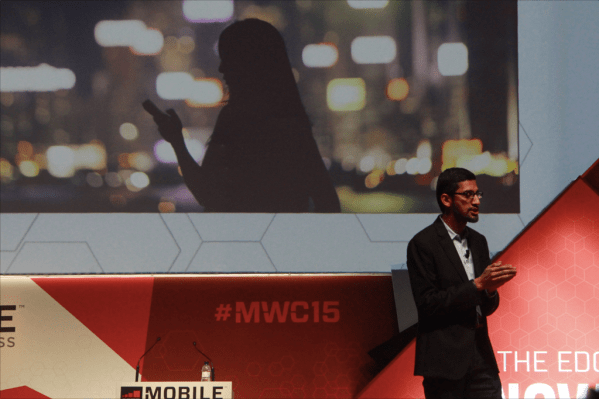Google SVP Sundar Pichai has given a few hints about what value Google sees in Magic Leap, the very well financed augmented reality startup that Mountain View led a $542 million investment round in last year, and which Pichai also sits on the board of.
He was being interviewed on stage here at Mobile World Congress in Barcelona where he also talked up the sprawl of Android — noting how the OS is pushing further and further, onto watches, TVs, even into cars. “We care about all form factors,” he said.
Magic Leap has not yet revealed in detail what it’s building — beyond talking about AR and some kind of “lightweight wearable”. Pichai wasn’t about to whip back the curtain on their hardware specifics but did sketch out one scenario where Google sees potential for Magic Leap’s tech: namely removing the inherent clunkiness that accompanies utilizing a cloud-based translation service on a smartphone when you’re trying to have a real-world conversation with another human being who speaks a foreign language.
In such a scenario, Pichai conceded a smartphone running Google Translate “does get in the way” of the human communication experience — the implication being that whatever Magic Leap is building will somehow help to smooth out such phone-focused awkwardness.
“I work closely with [Magic Leap]. If you see the experience of what they’re delivering where you can be looking at the real world and you bring computing to work in that context I think is very powerful,” said Pichai. “Think of the same translate experience we showed you [in a video about Google Translate]… while it’s great the phone does get in the way.
“The magic is seeing things in another language but having what it means in context. I think these are really powerful use cases,” he added. “I’m very positive that we will evolve these things.”
However, when it comes to Magic Leap’s technology, he also cautioned: “It’ll take some time.”
Games just the start for virtual reality
Asked how big a role he sees for virtual reality generally in the future, Pichai described it as “a nice evolution of computing”, again talking up how it can be incorporated into what people see “in a natural way”.
“To be able to enhance it in a natural way without getting in the way of it. It’s important. And will enable new use-cases which you couldn’t do with your phones,” he added.
Pichai also touched on the other strand of VR: the wholly immersive flavor that’s associated with headsets designed to take people away from their real world environment.
Only yesterday, here at MWC, HTC became the latest company to announce an immersive VR headset, called the Vive — in partnership with games company Valve. As with a device like the Oculus Rift, the Vive’s aim is to allow the wearer to feel transported out of their real world environs — to somewhere else completely.
“Having played around with something even as simple as [Google] Cardboard, which shows how for less than $10 you can create that kind of immersive experience shows what’s possible,” noted Pichai.
While much of the current VR focus is on gaming, this is just the first wave of VR in Pichai’s view — which makes sense given that Google’s own AR specs (Glass) were not designed for gaming but rather to be embedded into everyday life. That’s evidently where Google, which after all makes its money from targeting advertising, sees the real value in VR and AR: as a layer that even more tightly connects back-end computing and big data-mining to real-world human activity.
“Early on in these technologies the computing power you need tends to be the sort of use-cases which work well with gaming. Because gaming needs a lot of computing power, these devices need a lot of computing to make it work and so there’s good synergy,” said Pichai. “I think gaming will drive the early adoption of this. Just like we saw with PCs or with smartphones… Both for us and iOS, games have been a big part of it. But it starts there, then evolves into much broader use-cases. And we’ll see the same in VR”
Answering a question about what he sees coming in the next year in the mobile space, Pichai suggested wearables will be taking “concrete steps” and becoming “more often a part of your lives”.
“I’m excited about newer categories like VR,” he added.
Pichai suggested embedded cloud processing will be the driver for more people to adopt wearables — by allowing server-side clout to usefully augment people’s lives, and do so in a way that increasingly fades into the background (thanks to whatever sleight of hand the likes of Magic Leap has up its sleeve).
“For me the power of what you see is not just in devices, the focus of a place like this… these are computing devices, connected to the cloud… When I look at things like machine learning, AI, the kind of computing work we are doing to make these experiences much more powerful — that’s what will delight users in the next few years. I think we are working very hard to make these computing experiences much more seamless, and much more intelligent for users,” said Pichai.
“Most of computing has been automating what people do in their day to day lives. But I think we are at this exciting stage where we can do more. We can be very intelligent and genuinely help people.”
